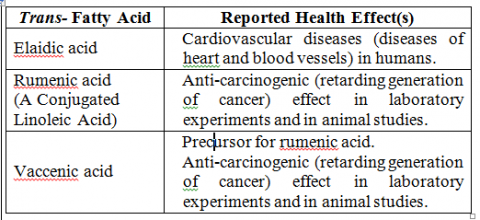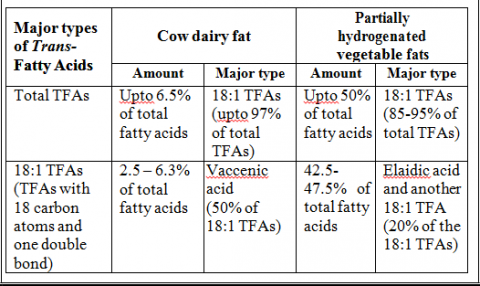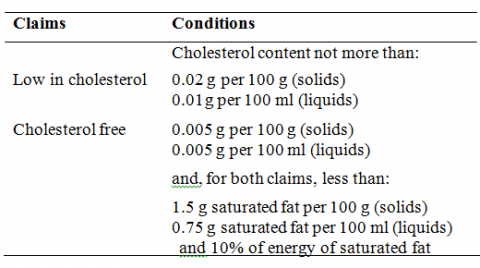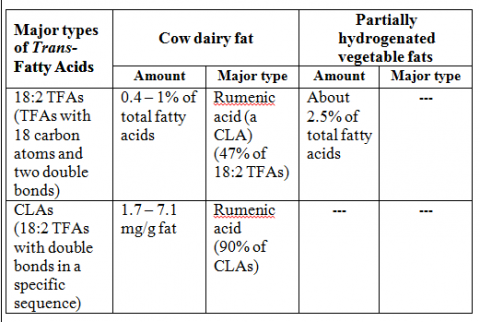TRANS-FATTY ACIDS AND CHOLESTEROL IN MILK AND DAIRY PRODUCTS
• Introduction
• Trans-Fatty Acids
• Cholesterol
• Epilogue
• News Section
1. INTRODUCTION
The presence of trans-fatty acids (TFAs) and cholesterol in milk and dairy products, and claimed association of these constituents with possible adverse health effects, has been often projected as a negative side of the consumption of dairy products. Codex Alimentarius Commission and several countries have labelling provisions in relation to the presence of these constituents in foods.
This issue of Technews provides general information on the TFAs and cholesterol; their types and levels in dairy and other foods as relevant; their effects on health; and dietary recommendations, labelling provisions and methods of analysis pertaining to these constituents.
2. TRANS-FATTY ACIDS
Fatty acids are one of the two major building blocks of fats, the other being the glycerol molecule. Trans- (Latin, across) fatty acids have a specific structural feature - the hydrogen atoms in a double bond lie on opposite sides of the molecule. On the other hand, in the cis- (Latin, on this side) fatty acids, both the hydrogen atoms in a double bond lie on the same side of the molecule.
The reasons for presence of TFAs in foods are 1: biohydrogenation (addition of hydrogen) of polyunsaturated cis- fatty acids by the rumen microflora in the ruminants; partial catalytic hydrogenation of oils and fats for industrial production of hydrogenated vegetable oils, margarines and shortenings; or heating of vegetable oils specially during deodorizing of oils in refining stage.
In humans and most animals, food intake chiefly provides cis- fatty acids, but also contains TFAs in some cases 1. The amount of TFAs in the diet depends upon the proportions of foods, that are source of TFAs, that constitute the diet. The reported effects on health in respect of the major TFAs found in foods are provided in Table 1.
Table 1: Major trans-fatty acids in foods and their reported effects on health
 Vaccenic acid Precursor for rumenic acid. Anti-carcinogenic (retarding generation
Vaccenic acid Precursor for rumenic acid. Anti-carcinogenic (retarding generation
Of cancer) effect in laboratory experiments and in animal studies. (Compilation based on information in the reference nos. 1 and 2)
2.1 Trans-Fatty Acids in Dairy and Other Relevant Foods
Mammals do not seem to synthesize TFAs. However, milk and, hence dairy products, contain TFAs as a result of biohydrogenation of (addition of hydrogen to) polyunsaturated cis-fatty acids by the rumen microflora in the ruminants 1.
Milk products contain an estimated 3 g of TFAs per 100 g milkfat, whereas margarines can contain 10 times this amount 3. In hydrogenated vegetable oils, the TFAs content varies widely and may account for about 50% of all fatty acids, whereas the TFAs content of dairy fats accounts only for up to about 6.5% of the total fatty acids 1, 2. The presence of TFAs in dairy products is natural and their amount and type is different than the TFAs found in the hydrogenated vegetable oils 1, 2. Animal fats, including milkfat, are a richer source of the Conjugated Linoleic Acids (CLAs) (chemically a type of TFAs) than vegetable oils 2. Table 2 provides information on major types of TFAs in dairy products and partially hydrogenated vegetable fats.
Table 2: Major Trans-Fatty Acids in Dairy Products and Partially

(Compilation based on information in the reference nos. 1 and 2)
2.2 Effects on Health
A review of the literature shows the growing evidence that all TFAs are not alike and that, due to the highly heterogeneous composition of TFAs in foods, it is of utmost importance to differentiate between the main sources, individual types of TFAs and their effect on human health 1, 2, 4.
Health effects of TFAs from hydrogenated vegetable oils
There is evidence that the ingestion of TFAs from partly hydrogenated or deodorized vegetable fats and oils exerts negative effects like elevated blood cholesterol levels which are linked to the incidences of cardiovascular diseases (diseases of heart and blood vessels) in humans (see Tables 1 & 2) 1, 2. In a study, the elaidic acid and another 18:1 TFA, that constitute 20% of the 18:1 TFAs in partially hydrogenated vegetable fats (Table 2), were shown to have positive correlation with the risk of coronary heart disease (CHD) 2. Presence of elaidic acid in diet may promote development of diabetes and may increase the intensity of existing diabetes 2.
Health effects of TFAs from dairy products
TFAs found in dairy fats do not seem to exert undesired effects on health (see Tables 1 & 2) 1, 2. Experts have reviewed the studies linking the TFAs in diet with possible increased risk of CHD and have indicated several gaps in the design and conduct of these studies, and other reasons for invalidity of their results in respect of natural TFAs found in dairy products 2. In most cases, the studies established the adverse effects of TFAs from hydrogenated vegetable oils on health and failed to take into account the fact that the natural TFAs, like those in milk fat are of different type, erroneously conveying that these would also exert similar adverse effects. It has been reported that there is no evidence that the prevailing TFA in milk exerts the same unfavorable effect as exerted by the TFAs of the hydrogenated vegetable oils in the diet 2.
On the other hand, dairy CLAs and the prevailing dairy TFA have been reported to promote beneficial health effects 1, 2, 3. Earlier studies have been reported to show health promoting effects of CLAs mixtures in animal trials mainly, including beneficial effects concerning onset of diabetes, carcinogenesis, atherosclerosis (undesirable hardening of blood vessels), fatty tissue mass, and body weight 2, 3. It is reported that, in contrast to the evidence that intake of total TFAs increases the CHD risk, a review of such studies has actually shown significant or non- significant reduction in CHD risk due to intake of animal or dairy TFAs, or at least no increase in the CHD risk with increase in intake of TFAs from such sources 2.
2.3 Dietary Recommendations
The World Health Organization (WHO) has recommended population nutrient intake goals for consideration by national and regional bodies establishing dietary recommendations for the prevention of diet-related chronic diseases which includes limiting the TFAs intake to not more than 1% of the total energy 2, 5. Although partially hydrogenated vegetable fats and oils are seen as the main source of dietary TFAs, dairy TFAs are not explicitly excluded from the general recommendation to limit the TFAs content in foods to reduce the risk of CHD 2.
2.4 Labelling Provisions
Codex and several countries have defined and elaborated specific labelling requirements for the TFAs in foods. Although CLAs are mainly excluded, dairy TFAs need still to be labelled because there is no sufficient knowledge on a differing metabolic behaviour 2. In India, the CLAs appear to be included in the TFAs for the purpose of labelling, due to absence of a specific definition for TFAs.
Codex Alimentarius Commission
As per the Codex Guidelines on Nutrition labelling (Codex GL 02-1985) 6, among others, the amount of TFAs may be required to be labelled according to national legislation in cases when a claim is made regarding the amount and/or type of fatty acids or the amount of cholesterol. For this purpose, Codex adopted the following definition of the term ‘trans- fatty acids’:
“Trans Fatty Acids*: For the purpose of the Codex Guidelines on Nutrition Labelling and other related Codex Standards and Guidelines, trans-fatty acids are defined as all the geometrical isomers of monounsaturated and polyunsaturated fatty acids having non-conjugated, interrupted by at least one methylene group, carbon carbon double bonds in the trans configuration.
* Codex Members may, for the purposes of nutrition labelling, review the inclusion of specific trans-fatty acids (TFAs) in the definition of TFAs if new generally accepted scientific data become available.”
It may be noted that the Codex definition of TFAs excludes the conjugated fatty acids and, therefore, the quantity of CLAs need not be included in the declared quantity of TFAs. Further, the footnote to the definition is intended to provide flexibility in respect of the specific TFAs that may be excluded from the definition of the TFAs by the countries based on credible scientific data.
Prevention of Food Adulteration Rules, India
In India, as per the Rule 32, Sub-rule (b), Clause (2), Sub-clause (vi) of the Prevention of Food Adulteration (PFA) Rules, 1955 the amount of TFAs in gram (g) shall be declared, among others, when a claim is made regarding the amount or type of fatty acids or the amount of cholesterol. Also, there is a provision that a health claim of ‘trans- fat free’ may be made in cases where the trans-fat is less than 0.2 g per serving of food 7.
There is, however, no definition of TFAs in PFA Rules. Therefore, the dairy CLAs, which are TFAs chemically, appear to be included in the TFAs for the purpose of labelling.
2.5 Methods of Analysis
Officially recognized analytical methods are necessary for estimation of TFAs in dairy products so that the labelling provisions can be implemented effectively.
The Codex Recommended Methods of Analysis and Sampling (CODEX STAN 234-1999) 8 indicates that the method no. AOCS Ce 1h-05 of the American Oil Chemists’ Society, based on the gas-liquid chromatography technique for estimation of the polyunsaturated fatty acids, can be used to measure TFAs for the purpose of nutrition labelling as per the Codex Guidelines on
Nutrition labelling (Codex GL 02-1985).
The official methods of analysis of the AOAC International 9 for estimation of TFAs are applicable to the food products containing >5% TFAs and, therefore, do not appear to be of much use for the dairy industry.
The manuals of method of analysis brought out by Ministry of Health and Family Welfare, Government of India and applicable vide the Rule 4, Subrule (9) of the Prevention of Food Adulteration (PFA) Rules, 1955 7 do not provide a specific method for estimation for TFAs in dairy products.
3. CHOLESTEROL
Cholesterol is the most common animal sterol (solid alcohol) and is also found in trace amounts in vegetable fats and oils, seaweeds and green leaves. It occurs naturally in animal fats and oils, bile, gallstones, nerve tissues, blood, brain, plasma and egg yolk. Cholesterol was first found in gallstones and derives its name from the Greek kholè (bile) and stereos (solid) The level of cholesterol in blood has been identified as an indicator of potential heart ailments. In recent years, various types of cholesterol in blood have been identified depending upon the type of lipoprotein (lipid – protein complex) that carries the cholesterol inside the body. The most commonly known types are the low density lipoproteins (LDL) – cholesterol and high density lipoprotein (HDL) – cholesterol. Elevated blood cholesterol levels, particularly the LDL-type is associated with the increased risk of the CHD. In contrast, a low level of HDL - cholesterol constitutes a major CHD risk factor 3. Accordingly, the LDL - cholesterol is commonly called the bad cholesterol and the HDL - cholesterol is commonly called the good cholesterol. It should be noted that the ‘bad’ and the ‘good’ cholesterol are the terms used to describe the types of cholesterol in blood (that is, inside the body), and there is no such classification for the cholesterol outside the body.
3.1 Cholesterol in Dairy Foods
Cholesterol is a normal constituent of milk, although milk contains relatively little cholesterol (i.e. less than 0.5% of milk fat). Thus, the cholesterol content in milk is in the range of about 0.01 – 0.02% depending upon the milch animal species, being lowest in goat milk and highest in buffalo milk. Its concentration in dairy products is related to their fat content 3 – increases with increasing fat content.
3.2 Effects on Health
Cholesterol is one of the most ubiquitous compounds in the body, being a vital structural component of every cell. In humans, it represents about 0.2% of the bodyweight 10.
Cholesterol is essential for life and serves many functions in the human body. In brain and nervous tissue it appears to act as an insulator; it is a lubricant in the skin and a precursor of a number of biologically important compounds such as important hormones and vitamin D. All humans need a continuous supply of cholesterol for the synthesis of new membranes and bile salts in the body 3, 10. The human body is known to biosynthesize cholesterol depending upon its requirement and availability from diet 10. Despite its essential role in the body, however, the significance of cholesterol is particularly linked to occurrence of heart diseases 10.
The positive association between elevated blood cholesterol and CHD risk is supported by extensive scientific findings. The desirable total blood cholesterol levels are below 200 mg/dl (dl = deciliter = 10ml). Total blood cholesterol values between 200-239 mg/dl are considered borderline-high and those above 240 mg/dl are considered high
3. It is, however, important to note that while the elevated blood cholesterol levels are linked to the increased risk of CHD, the dietary cholesterol generally has a limited influence on blood cholesterol levels within the range of dietary cholesterol usually consumed by most people.3 It has been reported that there is a relatively small increase in blood cholesterol – in the range of 1.35 – 2.67 mg/dl – for each 100 mg of dietary cholesterol ingested daily 11 and dairy foods make a relatively small contribution to cholesterol intake 3. It has also been reported that individuals vary widely in their blood cholesterol response to dietary cholesterol 3.
On the other hand, the type and amounts of dietary fats exert greater influence on blood cholesterol levels. A high intake of total and saturated fat and, to a lesser extent, cholesterol is associated with elevated blood total and LDL-cholesterol levels. In contrast, diets high in carbohydrate have been associated with reduced levels of blood total, LDL-, and HDL-cholesterol levels 3.
3.3 Dietary Recommendations
WHO has recommended population nutrient intake goals for consideration by national and regional bodies establishing dietary recommendations for the prevention of diet-related chronic diseases which includes limiting cholesterol intake to less than 300 mg/day 5.
3.4 Labelling
As per the Codex Guidelines on Nutrition labelling (Codex GL 02-1985) 6, among others, the amount of cholesterol should be declared on the label in cases when a claim is made regarding the amount and/or type of fatty acids or the amount of cholesterol.
Further, the Codex Guidelines on Use of Nutrition and Health Claims (Codex GL 23-1997) 12 provide for the following claims in respect of cholesterol under the specified conditions:
 In India, as per the Rule 32, Sub-rule (b), Clause (2), Sub-clause (vi) of the Prevention of Food Adulteration (PFA) Rules, 1955 the amount of cholesterol in milligram (mg) shall be declared, among others, when a claim is made regarding the amount or type of fatty acids or the amount of cholesterol 7.
In India, as per the Rule 32, Sub-rule (b), Clause (2), Sub-clause (vi) of the Prevention of Food Adulteration (PFA) Rules, 1955 the amount of cholesterol in milligram (mg) shall be declared, among others, when a claim is made regarding the amount or type of fatty acids or the amount of cholesterol 7.
3.5 Methods of Analysis
Officially recognized analytical methods are necessary for estimation of cholesterol in dairy products so that the labelling provisions can be implemented effectively.
The Codex Recommended Methods of Analysis and Sampling (CODEX STAN 234-1999) 8 does not specify a method for estimation of cholesterol in dairy products.
The Official Methods of Analysis of the AOAC International 9 include two methods based on gas-chromatography technique that can be used for estimation of cholesterol in dairy products. These are:
AOAC 976.26: Cholesterol in Multi-component Foods
AOAC 994.10: Cholesterol in Foods
The manuals of method of analysis brought out by Ministry of Health and Family Welfare, Government of India and applicable vide the Rule 4, Sub-rule (9) of the Prevention of Food Adulteration (PFA) Rules, 1955 7 do not provide a specific method for estimation for cholesterol in dairy products.
4. EPILOGUE
At present there is evidence of unfavourable effects of TFAs from hydrogenated vegetable oils on LDL- cholesterol and other risk factors of atherosclerosis (undesirable hardening of blood vessels). There is no evidence that the prevailing TFA in milk, vaccenic acid, does exert these unfavourable effects. On the other hand, CLAs – a group of TFAs - found in dairy products have been reported to promote beneficial health effects. It is of utmost importance to differentiate between the main sources, individual types of TFAs and their effect on human health.
Cholesterol is essential for life and serves many functions in the human body. Also, the positive association between elevated blood cholesterol and CHD risk is supported by extensive scientific findings. However, it is important to note that while the elevated blood cholesterol levels are linked to the increased risk of CHD, the dietary cholesterol generally has a limited influence on blood cholesterol levels within the range of dietary cholesterol usually consumed by most people. Moreover, the human body is known to biosynthesize cholesterol depending upon its requirement and availability from diet.
It must always be kept in view that milk and dairy products contain a wide range of nutrients with possibly far-reaching positive health effects. An adequate intake of milk and dairy products as part of a healthy, balanced diet is needed throughout the lifespan to promote health.
REFERENCES
1. IDF (2002). Trans-fatty Acids. Bulletin of the International Dairy
Federation No. 377. International Dairy Federation, Brussels, pp 20-31. IDF (2005).
2. Trans-Fatty Acids: Scientific Progress and Labelling. Bulletin of the International Dairy Federation No. 393. International Dairy Federation, Brussels, pp 1-19.
3. Miller, G.D., Jarvis, J.K. and McBean L.D. (2000). Handbook of Dairy Foods and Nutrition. Second Edition, National Dairy Council, CRC Press LLC, Florida, pp 1-116, 355-404.
4. IDF (2009). IDF Welcomes the Conclusions of the WHO Scientific Update on Trans-Fatty Acids. IDF Press Release, 19 May 2009, International Dairy Federation, Brussels.
5. WHO (2003). Diet, Nutrition and the Prevention of Chronic Diseases. World Health Organization, Geneva, Switzerland.
6. CAC (1985). Codex Guidelines on Nutrition labelling (Codex GL 02-1985). Codex Alimentarius Commission.
7. PFA (2009). Prevention of Food Adulteration (PFA) Rules, 1955.
Ministry of Health and Family Welfare, Government of India. Commercial Law Book Publishers (India) Private limited, Delhi.
8. CAC (1999). Codex Recommended Methods of Analysis and Sampling (CODEX STAN 234-1999). Codex Alimentarius Commission.
9. AOAC (2002). Official Methods of Analysis of AOAC International. 17th Edition, 2002.
10. Macrae, R., Robinson, R.K. and Sadler, M.J. (1993). Cholesterol.
Encyclopaedia of Food Science, Food Technology and Nutrition, Volume 2. Academic Press, pp 925-945.
11. IDF (2000). Dietary Cholesterol: Is there a Problem? Bulletin of the International Dairy Federation No.353. International Dairy Federation, Brussels, pp 22-24.
12. CAC (1997). Codex Guidelines on Use of Nutrition and Health Claims (Codex GL 23-1997). Codex Alimentarius Commission.
* * *
NEWS SECTION Indian Food Laws
• Notification No. GSR 151 (E) of 4 March 2009 of the Ministry of Consumer Affairs, Food and Public Distribution (Department of Consumer Affairs): The notification provides requirements for measuring systems for liquids other than water. It includes requirements for measuring systems used for milk including transportable measuring systems which are mounted on road tankers and used for the collection of milk; fixed measuring systems used for the reception of milk at the dairy; and fixed or transportable measuring systems used for the delivery of milk.
• Notification No. S.O. 650 (E) of 9 March 2009 of the
Ministry of Health and Family Welfare: It appoints 9 March
2009 as the date on which the provisions under Section 11 to 15 (both inclusive) of the food Safety and Standards Act (FSSA),
2006 shall come into force. These Sections pertain to the establishment of Central Advisory Committee (CAC), functions of the CAC, establishment of Scientific Panels, constitution of a Scientific Committee and the procedure for Scientific Committee and Scientific Panels, respectively, under the FSSA.
Codex Alimentarius Commission (CAC)
Meeting of the Codex Alimentarius Commission is scheduled during 29 June – 04 July 2009 in Rome, Italy.
International Dairy Federation (IDF)
IDF has published the following Bulletins/Standards recently:
• Bulletins
433/2009: A Revolution in Food Safety Management
434/2009: International Collaborative Study on the Gas- Liquid Chromatographic Method for the Determination of Milk Fat Purity in Milk and Milk Products by Analysis of Triglycerides - Draft international standard ISO 17678 / IDF 202
435/2009: Standardization of a Chemiluminescent Method to Detect Alkaline Phosphatase in Liquid Dairy Products
436/2009: Environmental / Ecological Impact of the Dairy Sector: Literature review on dairy products for an inventory of key issues - List of environmental initiatives and influences on the dairy sector
• Standards
IDF 063 - ISO 3356: Milk - Determination of alkaline phosphatase.
IDF 099-1 - ISO 22935-1: Milk and milk products - Sensory analysis - Part 1: General guidance for the recruitment, selection, training and monitoring of assessors.
IDF 099-2 - ISO 22935-2: Milk and milk products - Sensory analysis - Part 2: Recommended methods for sensory evaluation.
IDF 099-3 - ISO 22935-3: Milk and milk products - Sensory analysis - Part 3: Guidance on a method for evaluation of compliance with product specifications for sensory properties by scoring.
IDF 211 - ISO 23065: Milk fat from enriched dairy products - Determination of omega-3 and omega-6 fatty acid content by gas-liquid chromatography.
For purchasing the IDF publications, the following may be contacted:
Mr. Oscar Chavez
Office Manager
International Dairy Federation
Diamant Building
Boulevard Auguste Reyers 80
1030 Brussels
Belgium
E-mail: OChavez@fil-idf.org
Tel: +32 2 7069647
Fax: +32 2 7330413
TRANS-FATTY ACIDS AND CHOLESTEROL IN MILK AND DAIRY PRODUCTS

